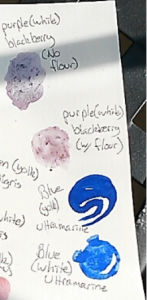I present to you the final installment of pigment-making. Bonnie and I have been researching various colors used in illuminated manuscripts as well as medieval and modern methods of making them (read the full explanation here). Recently, we attempted to recreate them for ourselves. Here are my notes and thoughts about our results for the color blue.
Since we are working off a professor’s budget (thank you, Dr. Camp), we could not afford lapis lazuli, one of the most expensive pigment-making materials which produces a beautiful and intense blue that has long been a staple in various forms of art. Because many medieval manuscripts were created in Western Europe, it was costly to transport the materials from the far east mountainous regions (think present-day Afghanistan). Not to mention the extraction process was laborious and even the powdered form: ultramarine, was expensive. Instead, we worked with a pre-ground jar of powdered ultramarine, likely not anywhere near as pure or natural as what most manuscript makers worked with.
Nonetheless, the intensity and smoothness of the color made it feel just as if we had purchased lapis lazuli. While we did not go the extent of buying any rocks or minerals to grind, even if we had, the color would not have been as smooth or beautiful simply because it is very hard for us to make a powder that fine by hand. Instead, the process became quite simple when we mixed the powder with egg yolk and egg white. Previously, we have discussed the merits of egg yolk versus egg white in other colors. The same seemed to hold true in this case.
 The egg yolk made a vibrant and opaque ultramarine blue. In contrast, the ultramarine pigment was not less beautiful when mixed with the egg yolk, but did take on a lighter, more watery blue that would be better suited for watercolor painting. After having worked with so much frustrating pigment-making processes, the ease and beauty with which the ultramarine pigment came together was a delight.
The egg yolk made a vibrant and opaque ultramarine blue. In contrast, the ultramarine pigment was not less beautiful when mixed with the egg yolk, but did take on a lighter, more watery blue that would be better suited for watercolor painting. After having worked with so much frustrating pigment-making processes, the ease and beauty with which the ultramarine pigment came together was a delight.
Our organic method to make blue pigment was pretty much the same as our method to make purple: blackberries and purple cabbage. We weren’t sure if they would would make a more purple or a more blue color and thought we might experiment with them to see which way it turned out. The results did not produce a very opaque or beautiful color, though it was more purple than blue. To read more about that process, skim through Bonnie’s explanation of purple pigment-making.
If you take nothing else away, just know that making pigment takes time, takes effort, takes patience. This project has taught us both plenty about the labor medieval pigment-makers put into these colors and it makes us appreciate it all the more. This upcoming Wednesday, we are excited to present our results and our labor so that Dr. Camp’s students can learn to make pigments and use them as well. Stay tuned for an update on that and our reflections on the project as a whole.